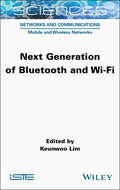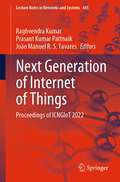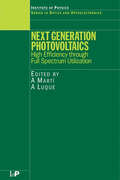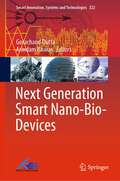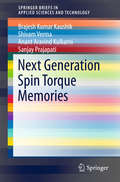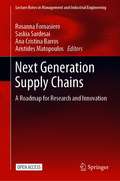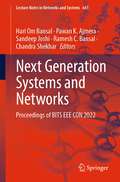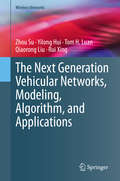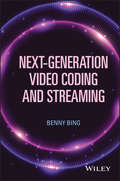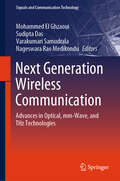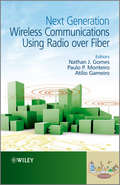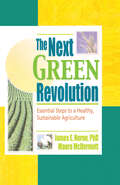- Table View
- List View
Next-Generation Nanobiosensor Devices for Point-Of-Care Diagnostics
by Gorachand DuttaThis book reviews the potential of next-generation point-of-care diagnosis in healthcare. It also discusses the printed chip-based assay (Lab-on-a-Chip, Lab-on-a-PCB) for rapid, inexpensive biomarkers detection. The book presents the development of sensory systems based on the use of nanomaterials. It examines different biosensors for medical diagnosis using surface modification strategies of transducers. It presents electrochemical concepts based on different nanobiomaterials and nanocomposites for cancer theranostics. Notably, the book examines the recent advances in wearable, cost-effective hemodynamic sensors to detect diseases at an early stage. It further explores the combination of redox cycling and electrochemical detection to develop ultrasensitive and reproducible biosensors for point-of-care testing. Finally, the book summarizes the significant challenges in the point of care diagnostics and its future opportunities in healthcare.
Next Generation of Bluetooth and Wi-Fi (ISTE Invoiced)
by Keunwoo LimThis book helps readers to understand the past (overview of technologies), current (how they are evolving) and the future (adaptation to new trends) of two representative communication technologies, Wi-Fi and Bluetooth. Wi-Fi and Bluetooth are technologies that are very familiar to us in our everyday lives. However, these technologies have evolved throughout the years to meet the continuously changing demands of users. Evolution of these technologies can be difficult to understand, even for professionals in the field of computer science and engineering, due to the extensiveness and complexity of written documents (technical standards and specifications are not very reader-friendly!). Next Generation of Bluetooth and Wi-Fi summarizes the key functions of Wi Fi and Bluetooth to show how they adapt to new environments and requirements. We introduce the new concepts that allow them to shift into the new paradigm of IoT and beyond, and we propose ideas and insights on how they could also possibly evolve in the future, integrated with other fascinating technologies.
The Next Generation of Distance Education
by Jason B. Huett Leslie MollerThe world of education is being radically altered with the change being driven by technology, openness, and unprecedented access to knowledge. Older correspondence-style methods of instructional delivery are passé and "classroom adapted to the web" approaches to learning are often ineffective and do little to harness the transformational potential of technology. E-Learning scenarios, mobile technologies, communication and information access, and personal learning environments are becoming mainstream and, as a result, control of the learning process is shifting away from institutions and into the hands of learners. This volumes promotes a forward-thinking agenda for research and scholarship that highlights new ideas, deep insights, and novel approaches to "unconstrained" learning.
Next Generation of Internet of Things: Proceedings of ICNGIoT 2021 (Lecture Notes in Networks and Systems #201)
by Raghvendra Kumar Brojo Kishore Mishra Prasant Kumar PattnaikThis book includes selected papers from the International Conference on Next Generation of Internet of Things (ICNGIoT 2021), organized by the Department of Computer Science and Engineering, School of Engineering, GIET University, Gunupur, Odisha, India, during 5–6 February 2021. The book covers topics such as IoT network design and architecture, IoT network virtualization, IoT sensors, privacy and security for IoT, SMART environment, social networks, data science and data analytics, cognitive intelligence and augmented intelligence, and case studies and applications.
Next Generation of Internet of Things: Proceedings of ICNGIoT 2022 (Lecture Notes in Networks and Systems #445)
by Raghvendra Kumar Prasant Kumar Pattnaik João Manuel R. S. TavaresThis book includes selected papers from the International Conference on Next Generation of Internet of Things (ICNGIoT 2022), organized by Department of Computer Science and Engineering, School of Engineering, GIET University, Gunupur, Odisha, India, during February 3–4, 2022. The book covers topics such as IoT network design and architecture, IoT network virtualization, IoT sensors, privacy and security for IoT, SMART environment, social networks, data science and data analytics, cognitive intelligence and augmented intelligence, and case studies and applications.
Next Generation Photovoltaics: High Efficiency through Full Spectrum Utilization (Series in Optics and Optoelectronics)
by Antonio Mart and Antonio LuqueAlthough photovoltaics are regarded by many as the most likely candidate for long term sustainable energy production, their implementation has been restricted by the high costs involved. Nevertheless, the theoretical limit on photovoltaic energy conversion efficiency-above 85%-suggests that there is room for substantial improvement of current comme
Next-Generation Plant-based Foods: Design, Production, and Properties
by David Julian McClements Lutz GrossmannThe creation of plant-based foods is one of the most rapidly advancing areas in the modern food industry. Many consumers are adopting more plant-based foods in their diets because of concerns about global warming and its devastating impacts on the environment and biodiversity. In addition, consumers are adopting plant-based diets for ethical and health reasons. As a result, many food companies are developing plant-based analogs of animal-based foods like dairy, egg, meat, and seafood products. This is extremely challenging because of the complex structure and composition of these animal-based foods.Next-Generation Plant-based Foods: Design, Production and Properties presents the science and technology behind the design, production, and utilization of plant-based foods. Readers will find a review of ingredients, processing operations, nutrition, quality attributes, and specific plant-based food categories such as milk and dairy products, egg and egg products, meat and seafood products, providing the fundamental knowledge required to create the next generation of healthier and more sustainable plant-based food alternatives.
Next-Generation Plant Breeding Approaches for Stress Resilience in Cereal Crops
by Mallana Gowdra Mallikarjuna S. Chandra Nayaka Tanushri KaulThis edited book highlights the gravity and efficacy of next-generation breeding tools for the enhancement of stress-resilience in cereals, especially in the context of climate change, pests, diseases, and abiotic stresses. The content of the book helps in understanding the application of emerging genetic concepts and neoteric genomic approaches in cereal breeding. It collates all the latest information about enhancing the stress resilience in cereal crops for overcoming food security issues. Cereals have predominantly been used as a staple food since time immemorial and contribute more than 50% of the caloric requirement of the global population. However, in cereals, the yield losses due to various stresses are very high, considering the crop growth stage and stress sensitivity. Therefore, to feed and nourish the generations in the era of climate change, it is imperative to develop stress-resilient cereal cultivars. This book explores newly developed next-generation breeding tools, viz., genome-wide association studies, genomic prediction, genome editing, and accelerated generation advancement methodologies, which revealed promising outcomes by enhancing the stress resilience in cereals with yield potential. This book is useful for postgraduate students specializing in plant breeding, plant stress physiology, plant genomics, agriculture, and agronomy. It is of immense value to scientific community involved in teaching, research, and extension activities related to cereal cultivation.
Next Generation Safety Leadership: From Compliance to Care
by Clive LloydNext Generation Safety Leadership illustrates practical applications that bring theory to life through case studies and stories from the author's years of experience in high-risk industries. The book provides safety leaders and their organisations with a compelling case for change. A key predictor of safety performance is trust, and its associated components of integrity, ability and benevolence (care). The next generation of safety leaders will take the profession forward by creating trust and psychological safety. The book provides safety leaders with actionable goals to enable positive change and translates academic languages into practical applications. It leaves the reader with a clear strategy to move forward in developing a safety plan and utilizes stories, humor, and case studies set in high-risk industries. Written primarily for the safety community and can be used to influence day to day safety operations in high-risk organisations.
Next Generation Science Standards: For States, By States
by Ngss Lead States“Next Generation Science Standards identifies the science all K-12 students should know. These new standards are based on the National Research Council’s A Framework for K-12 Science Education. The National Research Council, the National Science Teachers Association, the American Association for the Advancement of Science, and Achieve have partnered to create standards through a collaborative state-led process. The standards are rich in content and practice and arranged in a coherent manner across disciplines and grades to provide all students an internationally benchmarked science education. The print version of Next Generation Science Standards complements the nextgenscience.org website and: Provides an authoritative offline reference to the standards when creating lesson plans Arranged by grade level and by core discipline Printed in full color with a lay-flat spiral binding Allows for bookmarking”
Next Generation Sensors and Systems
by Subhas Chandra MukhopadhyayWritten by experts in their area of research, this book has outlined the current status of the fundamentals and analytical concepts, modelling and design issues, technical details and practical applications of different types of sensors and discussed about the trends of next generation of sensors and systems happening in the area of Sensing technology. This book will be useful as a reference book for engineers and scientist especially the post-graduate students find will this book as reference book for their research on wearable sensors, devices and technologies.
Next Generation Sequencing and Whole Genome Selection in Aquaculture
by Zhanjiang (John) LiuRecent developments in DNA marker technologies, in particular the emergence of Single Nucleotide Polymorphism (SNP) discovery, have rendered some of the traditional methods of genetic research outdated. Next Generation Sequencing and Whole Genome Selection in Aquaculture comprehensively covers the current state of research in whole genome selection and applies these discoveries to the aquaculture industry specifically. The text begins with a thorough review of SNP and transitions into topics such as next generation sequencing, EST data mining, SNP quality assessment, and whole genome selection principles. Ending with a discussion of the technology's specific applications to the industry, this text will be a valuable reference for those involved in all aspects of aquaculture research. Special Features: Unique linking of SNP technologies, next generation sequencing technologies, and whole genome selection in the context of aquaculture research Thorough review of Single Nucleotide Polymorphism and existing research 8-page color plate section featuring detailed illustrations
Next Generation Smart Grids: Modeling, Control and Optimization (Lecture Notes in Electrical Engineering #824)
by Papia Ray Surender Reddy SalkutiThis book is a collection of chapters describing the advanced and future aspects of smart grid technology. The book emphasizes technical issues, theoretical background and practical applications that drive postgraduates, researchers and practicing engineers with the right advanced skills, vision and knowledge who will further be capable of leading in teams involved in the modelling, control, design, and optimization of the future smart grids. This feature strengthens the benefits of the book for the readers who will gain an insightful understanding of future smart grid challenges including: (i) the formulation of decision-making models, (ii) the familiarization with efficient solution algorithms for such models and (iii) insights into these problems through the detailed analysis of numerous illustrative examples. Further the chapters in this book provide comprehensive coverage of modelling, control and optimization of smart grid which are quite different from most technical publications.
Next Generation Smart Nano-Bio-Devices (Smart Innovation, Systems and Technologies #322)
by Gorachand Dutta Arindam BiswasThis book addresses challenges for the development of a point-of-care-test platform. The book describes printed chip-based assay (Lab-on-a-Chip, Lab-on-a-PCB) for rapid, inexpensive biomarkers detection in real samples. The main challenges of point-of-care testing require implementing complex analytical methods into low-cost technologies. This is particularly true for countries with less developed healthcare infrastructure. Washing-free, Lab-on-Chip, and Lab-on-PCB techniques are very simple and innovative for point-of-care device development. The redox cycling technology detects several interesting targets at the same time on a printed chip. The proposed areas are inherently cross-disciplinary, combining expertise in biosensing, electrochemistry, electronics and electrical engineering, health care, and manufacturing. This book focuses on recent advances and different research issues in the nanobiotechnology-enabled biosensor technology and also seeks out theoretical, methodological, well-established, and validated empirical work dealing with these different topics.
Next Generation Spin Torque Memories
by Brajesh Kumar Kaushik Shivam Verma Anant Aravind Kulkarni Sanjay PrajapatiThis book offers detailed insights into spin transfer torque (STT) based devices, circuits and memories. Starting with the basic concepts and device physics, it then addresses advanced STT applications and discusses the outlook for this cutting-edge technology. It also describes the architectures, performance parameters, fabrication, and the prospects of STT based devices. Further, moving from the device to the system perspective it presents a non-volatile computing architecture composed of STT based magneto-resistive and all-spin logic devices and demonstrates that efficient STT based magneto-resistive and all-spin logic devices can turn the dream of instant on/off non-volatile computing into reality.
Next Generation Supply Chains: A Roadmap for Research and Innovation (Lecture Notes in Management and Industrial Engineering)
by Rosanna Fornasiero Saskia Sardesai Ana Cristina Barros Aristides MatopoulosThis open access book explores supply chains strategies to help companies face challenges such as societal emergency, digitalization, climate changes and scarcity of resources. The book identifies industrial scenarios for the next decade based on the analysis of trends at social, economic, environmental technological and political level, and examines how they may impact on supply chain processes and how to design next generation supply chains to answer these challenges. By mapping enabling technologies for supply chain innovation, the book proposes a roadmap for the full implementation of the supply chain strategies based on the integration of production and logistics processes. Case studies from process industry, discrete manufacturing, distribution and logistics, as well as ICT providers are provided, and policy recommendations are put forward to support companies in this transformative process.
Next Generation Systems and Networks: Proceedings of BITS EEE CON 2022 (Lecture Notes in Networks and Systems #641)
by Hari Om Bansal Pawan K. Ajmera Sandeep Joshi Ramesh C. Bansal Chandra ShekharThe book is a collection of high-quality research papers presented at International Conference on Next Generation Systems and Networks (BITS EEE CON 2022), held at Birla Institute of Technology & Science, Pilani, Rajasthan, India, during November 4–5, 2022. This book provides reliable and efficient design solutions for the next-generation networks and systems. The book covers research areas in energy, power and control; communication and signal processing; and electronics and nanotechnology.
Next Generation Telecommunications Networks, Services, and Management (IEEE Press Series on Networks and Service Management #15)
by Thomas Plevyak Veli SahinAn unprecedented look into the present and future of next generation networks, services, and management in the telecommunications industry The telecommunications industry has advanced in rapid, significant, and unpredictable ways into the twenty-first century. Next Generation Telecommunications Networks, Services, and Management guides the global industry and academia even further by providing an in-depth look at current and developing trends, as well as examining the complex issues of developing, introducing, and managing cutting-edge telecommunications technologies. This is an orchestrated set of original chapters written expressly for this book by topic experts from around the globe. It addresses next generation technologies and architectures, with the focus on networks, services, and management. Key topics include: Opportunities and challenges of next generation telecommunications networks, services, and management Tri/Quad Play and IP-based networks and services Fault, Configuration, Accounting, Performance, and Security (FCAPS) requirements Convergence and an important convergence vehicle, IP Multimedia Subsystem (IMS) Next generation operations and network management architecture Ad hoc wireless and sensor networks and their management Next generation operations and network management standards from a strategic perspective A defining look at the future in this field This book will serve as a contemporary reference for the growing global community of telecommunication and information professionals in industry, government, and academia. It will be important to faculty and graduate students of telecommunications as a graduate textbook.
The Next Generation Vehicular Networks, Modeling, Algorithm and Applications (Wireless Networks)
by Zhou Su Yilong Hui Tom H. Luan Qiaorong Liu Rui XingThis book proposes the novel network envisions and framework design principles, in order to systematically expound the next generation vehicular networks, including the modelling, algorithms and practical applications. It focuses on the key enabling technologies to design the next generation vehicular networks with various vehicular services to realize the safe, convenient and comfortable driving. The next generation vehicular networks has emerged to provide services with a high quality of experience (QoE) to vehicles, where both better network maintainability and sustainability can be obtained than before.The framework design principles and related network architecture are also covered in this book. Then, the series of research topics are discussed including the reputation based content centric delivery, the contract based mobile edge caching, the Stackelberg game model based computation offloading, the auction game based secure computation offloading, the bargain game based security protection and the deep learning based autonomous driving. Finally, the investigation, development and future works are also introduced for designing the next generation vehicular networks.The primary audience for this book are researchers, who work in computer science and electronic engineering. Professionals working in the field of mobile networks and communications, as well as engineers and technical staff who work on the development or the standard of computer networks will also find this book useful as a reference.
Next-Generation Video Coding and Streaming
by Benny BingReviews the new High Efficiency Video Coding (HEVC) standard and advancements in adaptive streaming technologies for use in broadband networks and the InternetThis book describes next-generation video coding and streaming technologies with a comparative assessment of the strengths and weaknesses. Specific emphasis is placed on the H.265/HEVC video coding standard and adaptive bit rate video streaming. In addition to evaluating the impact of different types of video content and powerful feature sets on HEVC coding efficiency, the text provides an in-depth study on the practical performance of popular adaptive streaming platforms and useful tips for streaming optimization. Readers will learn of new over-the-top (OTT) online TV advancements, the direction of the broadband telecommunications industry, and the latest developments that will help keep implementation costs down and maximize return on infrastructure investment. Reviews the emerging High Efficiency Video Coding (HEVC) standard and compares its coding performance with the MPEG-4 Advanced Video Coding (AVC) and MPEG-2 standards Provides invaluable insights into the intra and inter coding efficiencies of HEVC, such as the impact of hierarchical block partitioning and new prediction modes Evaluates the performance of the Apple and Microsoft adaptive streaming platforms and presents innovative techniques related to aggregate stream bandwidth prediction, duplicate chunk Includes end-of-chapter homework problems and access to instructor slides Next-Generation Video Coding and Streaming is written for students, researchers, and industry professionals working in the field of video communications.Benny Bing has worked in academia for over 20 years. He has published over 80 research papers and 12 books, and has 6 video patents licensed to industry. He has served as a technical editor for several IEEE journals and an IEEE Communications Society Distinguished lecturer. He also received the National Association of Broadcasters (NAB) Technology Innovation Award for demonstrations of advanced media technologies.
Next Generation Wireless Communication: Advances in Optical, mm-Wave, and THz Technologies (Signals and Communication Technology)
by Sudipta Das Mohammed El Ghzaoui Varakumari Samudrala Nageswara Rao MedikonduThis book provides an overview of the most common techniques and methods employed in wireless fields. Conversely, it delves into a detailed study of millimeter-wave (mm-wave) and terahertz (THz) systems, with a focus on various schemes for transmitting and receiving electromagnetic waves. The title comprehensively reviews key elements associated with wireless communications, emphasizing the generation and detection of mm and THz waves. It explores specifications, innovations in new materials for high-speed terahertz and millimeter-wave technology, and considerations related to components and system aspects. Additionally, the book explores the integration of machine learning (ML) and artificial intelligence (AI) in smart communication systems, along with potential applications for advanced wireless communications. Furthermore, it concentrates on recent advances and diverse research prospects in Next-Generation Wireless Communication Technologies. The book also seeks theoretical, methodological, well-established, and validated empirical work addressing these various topics.
Next Generation Wireless Communications Using Radio over Fiber
by Paulo P. Monteiro Atílio Gameiro Nathan J. GomesTaking a coherent and logical approach, this book describes the potential use of co-ordinated multipoint systems supported by radio over fiber. It covers an impressive breadth of topics, ranging from components, subsystem and system architecture, to network management and business perspectives. The authors show the importance of radio over fiber in eliminating or mitigating against the current, perceived barriers to the use of co-ordinated multipoint, and the drivers for standardisation activities in future mobile/wireless systems over the next few years.The book brings together the system concept for centralized processing, including what is required for co-existence with legacy wireless systems, the algorithms that can be used for improving wireless bandwidth utilization at physical and MAC layers and the radio over fiber network and link design necessary to support the wireless system. Other important research is also covered as the authors look at compensating for radio over fiber impairments and providing simple network management functions. A study of service provision and the business case for such a future wireless system is also fully considered.This book comes at an important time for future wireless systems with standardization of fourth generation wireless systems still ongoing. The content enables readers to make key decisions about future standardisation and their own research work. The business analysis also makes the book useful to those involved in deciding the future directions of telecoms organisations. This information will be core to their decision-making as it provides technical knowledge of the state-of-the-art but also system level assessments of what is possible in a business environment.
Next Generation Wireless Terahertz Communication Networks
by Saim GhafoorThe rapid growth of the data traffic demands new ways to achieve high-speed wireless links. The backbone networks, data centers, mission-critical applications, as well as end-users sitting in office or home, all require ultra-high throughput and ultra-low latency wireless links. Sophisticated technological advancement and huge bandwidth are required to reduce the latency. Terahertz band, in this regard, has a huge potential to provide these high-capacity links where a user can download the file in a few seconds. To realize the high-capacity wireless links for future applications, in this book, different aspects of the Terahertz band wireless communication network are presented. This book highlights the Terahertz channel characteristics and modeling, antenna design and beamforming, device characterization, applications, and protocols. It also provides state-of-the-art knowledge on different communication aspects of Terahertz communication and techniques to realize the true potential of the Terahertz band for wireless communication.
The Next Green Revolution: Essential Steps to a Healthy, Sustainable Agriculture
by Raymond P Poincelot Jim Horne Maura McdermottExplore the benefits of and necessity for sustainable agriculture!Here is an easy-to-read, practical introduction to sustainable agriculture: what it means and why it is needed. It is the first book to synthesize the goals of sustainable agriculture into eight comprehensive steps. The Next Green Revolution presents a convincing critique of our current agricultural system and an introduction to an alternative system which gives more consideration to future generations. Interwoven through the book are Dr. Horne's reflections on social justice, quality of life, and how farmers and rural communities are inextricably linked.The Next Green Revolution draws on the unique perspective of Dr. James E. Horne, President of a leading nonprofit agriculture organization, the Kerr Center for Sustainable Agriculture. It is inspired by his experience as a traditional agriculturalist and educator coming to grips with the failings of the conventional system and searching for an alternative. Writing in the first person, he describes growing up in a sharecropper family in Oklahoma, running his own ranch, and consulting with farmers as an agricultural economist. He shares what he learned as the Kerr Center experimented with new “sustainable” approaches to old problems on the Center's ranch/farm, and his experiences working with the USDA's Sustainable Agriculture Research and Education Program. With The Next Green Revolution, you will explore: the major problems of contemporary industrial agriculture definitions of sustainable agriculture the historical roots of sustainable agriculture the politics of sustainable agriculture sustainable agriculture practices changes needed to encourage a sustainable agriculture and the eight steps to sustainable agriculture, which address: soil health and erosion water quality and use organic waste management crop and livestock adaptation biodiversity environmentally benign pest management energy use farm diversification profitability The Next Green Revolution is a well-researched introduction to the field, written with a minimum of jargon.
The Next One Hundred Years: Shaping the Fate of Our Living Earth
by Jonathan WeinerA detailed but non-technical analysis of the state of the planet today and during the next century by the author of Planet Earth.

